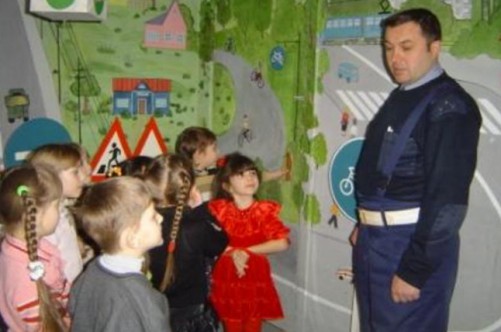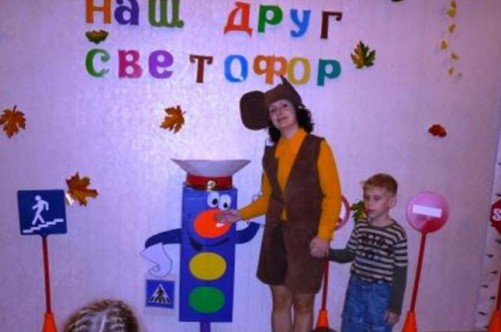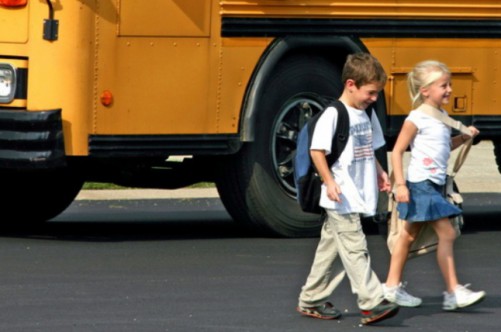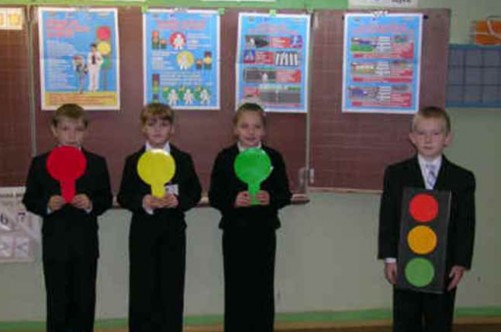Basic rules of conduct on the road. Memo for schoolchildren "rules of safe behavior on the roads"
Memo to the student SAFETY ON THE ROAD
Every year in our country, children become victims of road accidents. Every day you go out and become participants traffic. Very often, children violate the rules of the road or do not know them at all. Let's now, after reading this memo, remember the basic rules and will not violate them.
BASIC RULES OF SAFE BEHAVIOR ON THE ROAD
- Never run into the road in front of an approaching vehicle. This is dangerous because the driver cannot stop the car immediately.
- The road must be crossed in specially designated places on pedestrian crossing.
- On the carriageway get out only after you make sure that there is no approaching transport on both the left and right.
- When you get off the bus, do not run out onto the road. Wait for the bus to leave, and only then, making sure there are no cars, cross the road.
- It is dangerous to ride on the roadway on skateboards and roller skates.
- Do not run out onto the road outside the pedestrian crossing zone, in this place the driver does not expect pedestrians and will not be able to immediately stop the car.
- It is dangerous to play ball and other games near carriageway, it is better to do this in the yard or on the playground.
- Don't use traffic lights.
Remember!
Only strict adherence
The rules of the road protect you all from the dangers on the road.
Memo for parents on teaching children the rules of the road
- Do not rush, cross the road at a measured pace.
- When you go out onto the carriageway, stop talking - the child should get used to the fact that when crossing the road you need to concentrate.
- Do not cross the road at a red or yellow traffic light, no matter how fast you are.
- Cross the road only in places marked road sign"Crosswalk".
- Get out of the bus, trolleybus, tram, taxi first. Otherwise, the child may fall or run into the roadway.
- Involve your child in your observations of the situation on the road, show him the cars that are preparing to turn, go at high speed, etc.
- Do not go out with a child from behind bushes or a car without first examining the road - this typical mistake and children should not be allowed to repeat it.
- Do not allow children to play near the road and on the roadway.
Memo for parents on the rules of the road
- It is necessary to teach children not only to observe the Rules of the road, but also to teach them to observe and navigate from a very early age.
- It should be borne in mind that the main way to form behavioral skills is observation, imitation of adults, especially parents. Many parents, not realizing this, teach their children wrong behavior by personal example.
- When you are on the road with your child, do not rush, cross the road at a measured pace. Otherwise, you will teach to rush where you need to observe and ensure safety.
- Do not send your child to cross or run across the road in front of you - this is how you teach him to walk across the road without looking around. A small child must be firmly held by the hand, be ready to hold when trying to escape - this is a typical cause of accidents.
- Teach your child to look. The child must develop a solid habit: before taking the first step off the sidewalk, he turns his head and examines the road in all directions. This should be brought to automatism.
- Teach your child to notice the car. Sometimes a child does not notice a car or a motorcycle from afar. Teach him to look into the distance.
- Teach your child to estimate the speed and direction of the future movement of the car.
- Teach your child to identify which car is going straight and which is preparing to turn. Firmly learn for yourself and teach your child that you can enter and exit any type of transport only when it is standing. Explain to the child why you can not jump on the go
The rules of the road for schoolchildren must be learned from a very early age, as this will avoid many problems on the roads in the future.
Scenarios according to the rules of the road for schoolchildren usually present in a playful way the basic norms according to which traffic is carried out on highways.
Traffic rules for schoolchildren are designed to teach even students lower grades know, understand and comply with existing regulations that govern the movement and road transport, and pedestrians. For first graders best solution there will be a study of the norms through a scenario for traffic rules for schoolchildren, which is compiled in strict accordance with the methodological recommendations.
It should describe not only the basic rules defined by law, but also briefly describe the signs installed on the road and the markings applied to it. Thanks to this, the child will not only be confident in himself, even crossing the road for the first time. In addition, in the event of force majeure or a critical situation, he will be able to make the right decision.

To date, the problem of ensuring the proper level of traffic safety on the road for schoolchildren is one of the main goals of the institutions responsible for this. Since the standard of living of the population is constantly increasing, the number of personal vehicles is also increasing accordingly. But most drivers are not going to follow the rules, which means that the level of safety is constantly falling, and the number of accidents, collisions and other incidents on the road is growing.
Unfortunately, these cases are not uncommon for schoolchildren, who are most often the victims. Psychologists say that such situations occur because children often simply cannot orient themselves and react appropriately, because they have no idea what to do. It can also be noted that the child often does not pay due attention to the existing rules, even if he was familiar with them. It is for this reason that the state should make every effort to ensure that the teaching of traffic rules in educational institutions motivated children to follow them.
It is also worth emphasizing that Small child always begins his training by taking an example from the adults around him. In no case should you spare time for teaching the baby and explaining the rules to him. Only thanks to this approach can the child be protected from the threat of accidents on the road.
There are several basic rules, and you should definitely not only tell and explain them, but also show them by example, taking the baby with you for a walk.

Before crossing the street, you should first look into left side, and only coming to the middle of the carriageway - to the right.
If there is no such means of crossing the roadway in the vicinity, then it is worth using the crossing, which has a traffic light.
When walking outside the borders settlements, children can only move together with adults on the road lane that is oncoming.

Public transport, and in particular, trams and buses, is not recommended to bypass both behind and in front. The best way out is to find the nearest transition and use it.
You should not run out sharply into the roadway, because in this case the driver may simply not be able to slow down. Before you get on the road, you should slow down and look around.
Games on the road are not safe, and the same goes for entertainment near the roadway, because in the heat of the game you can not notice the danger.
If there are doubts and self-doubt, then for the first time it is better to cross the road with large groups of people.

Motorway safety also applies to personal travel. vehicle Therefore, parents need to teach this to children from an early age. Teaching the rules of conduct should begin as early as possible, because the older child becomes, the more difficult it is to teach him to obey the rules that suddenly arise.
It is worth accustoming the baby to sit exclusively in the back, and fasten the belt at the same time. It is not recommended to allow a child to move into the seat next to the driver, if there is no special seat for children. You should pull the baby in time if he decides to stand up to his full height on the seat while the car is moving; this rule applies even to the smallest children who have not reached a year. The fact is that a sharp jerk of the car or a collision can provoke injury. Very often, when this happens, the child flies over the front seat and hits the glass, which leads to accidents. Do not let children in the car without adult supervision, as this can sometimes lead to embarrassing accidents.
All of the above rules are quite simple and effective, and their observance allows you to completely eliminate the likelihood of accidents with a child while crossing even busy transport routes.
Legal Bulletin for TeensRoad Safety
Five simple rules,
to be safe on the road
Remember!
Save a minute - lose a life!
In the city, children should only walk on the sidewalk, not on the roadway. If there is no sidewalk, then you need to walk on the left side of the street, that is, towards the traffic.
2. The street must be crossed at a pedestrian crossing ("zebra"). First, stop at the edge of the sidewalk and watch the traffic. If the road is regulated by a traffic light, you need to wait for the green light for pedestrians, then make sure that all cars have stopped and only then cross the street.
Do you know?
Pedestrians are responsible for their actions before the law.
A pedestrian who caused an accident in which a cyclist was injured may be found guilty of bodily injury or unintentional damage if the pedestrian is over 16 years old (if younger, then parents are responsible).
If a pedestrian crosses the road at a red light or at a distance of less than 50 meters from a pedestrian crossing, he can be fined.
Before crossing the street (even at a pedestrian crossing), you need to look to the left, then to the right, reaching the middle of the street - again to the right. Do not stand behind a car that is pulling out of a parking lot or parked. The driver may not notice you. In addition, you can’t cross the street either in front of or behind a bus, trolleybus, tram standing at a stop: the driver may not notice the pedestrian because of the traffic. You need to wait until the bus leaves and only then start the transition.
4. In no case should you go off the sidewalk onto the carriageway, even if other pedestrians prevent you from passing.
5. Before you go cycling or rollerblading, you must put on protective equipment and attach pieces of reflective material if it is dark outside.
How to behave on the street
Statistics
In Russia in 2013:
Happened over204 068
thousand accidents. People died in them27 025,
of which children
over 872 people injured258 437.
The greatest risk group is children from 5 to 9 years old.
In 35% of cases, the victims were children who crossed the road at a pedestrian crossing.
Accidents caused by drunk drivers 13 581
Accidents caused by pedestrians 28 177
accident due to bad roads 53 080
Be aware of other pedestrians, always look ahead to avoid bumping into them. Do not go out on the roadway, walk along the sidewalk. If you are walking on a road that does not have a sidewalk, walk on the left side, that is, on the side with oncoming traffic. Cross the street only at the pedestrian crossing and green light traffic light. When crossing the street, always look carefully to the left, then to the right, then to the left again. When you reach the middle of the street, look again to the right. Be careful not to throw anything on the road, otherwise it may lead to an accident.
When you are driving
Children before 12 years of age must sit in a car in the back seat of a car, preferably in a fixed seat with a seatbelt fastened. Do not divert the driver's attention from the road - this can lead to an accident. It is very dangerous to throw any objects on the roadway and lean out of the car window - this can lead to unpleasant consequences for you and other people. Get out of the car only on the sidewalk.
When you rollerblade
If you are roller skating, you move much faster than pedestrians, so you need to be extra careful. Sidewalks and roads are not suitable for you to ride, ride only in specially designated places (parks, stadiums, paths, gardens, safe yards). Be sure to wear all protective equipment (elbow pads, knee pads, hand guards and a helmet), do not speed up when competing with older guys, and keep your speed under control. If it seems to you that a passer-by cannot see you, warn him in a loud voice of a possible danger.
Important!
Don't neglect these tips. Following them could save over 3,000 lives every year!





